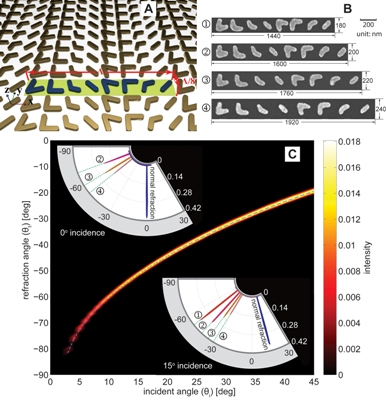Using plasmonic nanoantenna arrays, Purdue University researchers have demonstrated new ways of accurately manipulating the propagation of light by modifying its phase, opening the door for new class of optical advancements such as powerful computers, telecommunications and microscopes.
 The image in the upper left shows a schematic for an array of gold "plasmonic nanoantennas" able to precisely manipulate light in new ways, a technology that could make possible a range of optical innovations such as more powerful microscopes, telecommunications and computers. At upper right is a scanning electron microscope image of the structures. The figure below shows the experimentally measured refraction angle versus incidence angle for light, demonstrating how the nanoantennas alter the refraction. (Purdue University Birck Nanotechnology Center image)
The image in the upper left shows a schematic for an array of gold "plasmonic nanoantennas" able to precisely manipulate light in new ways, a technology that could make possible a range of optical innovations such as more powerful microscopes, telecommunications and computers. At upper right is a scanning electron microscope image of the structures. The figure below shows the experimentally measured refraction angle versus incidence angle for light, demonstrating how the nanoantennas alter the refraction. (Purdue University Birck Nanotechnology Center image)
This Purdue University research is based on the work of researchers at the Harvard School of Engineering and Applied Sciences. The Harvard scientists revised Snell’s law, which explains the behavior of light bending, refraction and reflection during its propagation from one object into other. They demonstrated that it is possible to change the phase and propagation direction of light drastically by utilizing metamaterials, which here were a sequence of antennas.
The Purdue scientists have extended the Harvard research work by forming arrays of nanoantennas for modifying the propagation direction and the phase of light over a wide near-infrared light range. The nanoantennas having 40-nm width are V-form structures made of gold and created over a silicon layer. They are metamaterials comprising plasmonic structures to transfer plasmons, which are electron clouds. The Purdue researchers were able to demonstrate the transmission of light via a plasmonic nanoantenna layer that is 50 folds thinner than the wavelength of the light being transmitted. These arrays of nanoantennas are capable of bending the light in a broad array of angles that include negative refraction angles.
Vladimir Shalaev, who serves as Scientific Director of Nanophotonics at the Birck Nanotechnology Center of Purdue University, explained that this plasmonic nanoantenna ultrathin layer rapidly and strongly modifies the phase of light, which in turn modifies the propagation direction of the light according to its momentum conservation during its passage via the interface between the objects.
The Harvard scientists explained the modified Snell’s law at one wavelength, while the Purdue researchers have extended the principle to the near infrared regime, which is a highly broadband effect, paving the way for novel technological innovations, including nanocircuits for computers that utilize light for information processing, microscopes with a new class of powerful lenses, and shaping and manipulating laser beams for communications and military applications.